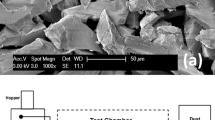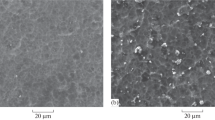Conclusions
-
1.
The hydrogen content in chemically reduced Ni-B coatings is ≈0.02%, regardless of the amount of boron in the alloy.
-
2.
The rate of evolution of hydrogen during the heating of the coatings is related to the structural-phase transformations that occur in them.
-
3.
A comparison of the data on the evolution of hydrogen with thermographic data gives a basis for believing that the hydrogen contained in the coatings is partially present in the atomic state, partially in a protonated state.
-
4.
The laminarity detected for certain coatings is considered as a consequence of a periodic variation in the ratio of the rates of reduction of nickel and boron, which are inversely dependent on the acidity of the medium.
Similar content being viewed by others
Literature cited
K. Lang, Metalloberfläche,19, No. 8, 257 (1965).
K. Lang, Electroplat. and Metal Finish,19, No. 3, 86 (1966).
K. M. Gorbunova, M. V. Ivanov, M. M. Mel'nikova, and A. A. Nikiforova, Results of Science, Electrochemistry, 1968 [in Russian], VINITI, Moscow (1970), p. 112.
G. Mallory, Soc. Automotive Engngs. Preprints, S. A. No. 690, 646 (1969).
K. Lang, Galvanotechnik,56, No. 6, 347 (1965).
T. Kanbe, J. Met. Finish. Soc. Japan,20, No. 6, 279 (1969).
T. Berzins, U. S. Patent No. 3096182 (1963); RZhKhim. 7L24OP (1965).
H. Kyri, K. Lang, H. G. Klein, French Patent No. 1383483 (1964), Chem. Abstrs.,63, 9623a (1965).
K. M. Gorbunova, in: Transactions of the International Conference on Electrochemistry, Warsaw [in Russian], Nauka (1957), p. 483.
Yu. M. Polukarov, Zh. Fiz. Khimii,32, 1008 (1958).
K. M. Gorbunova, M. V. Ivanov, and A. A. Nikiforova, Zashchita Metal.,6, No. 5, 552 (1970).
M. V. Ivanov, A. A. Nemodruk, and A. A. Nikiforova, Dep. VINITI, No. 1322-70 (1970).
O. S. Popova and K. M. Gorbunova, Zh. Fiz. Khimii,32, 2020 (1958).
K. M. Gorbunova and A. A. Nikiforova, Zh. Fiz. Khimii,28, 883 (1954).
K. M. Gorbunova and A. A. Nikiforova, Physico-Chemical Bases of the Process of Chemical Nickel Plating [in Russian], Izd-vo Akad. Nauk SSSR, Moscow (1960), p. 89.
A. A. Nikiforova and G. A. Sadakov, Élektrokhimiya,3, 1207 (1967).
M. V. Ivanov, V. P. Moiseev, and K. M. Gorbunova, Dokl. Akad. Nauk SSSR,194, 610 (1970).
V. P. Moiseev, G. A. Sadakov, and K. M. Gorbunova, Zh. Fiz. Khimii,42, 2751 (1968).
M. V. Ivanov, K. M. Gorbunova, A. A. Nikiforova, and V. P. Shcheredin, Dokl. Akad. Nauk SSSR,199, 1317 (1971).
Author information
Authors and Affiliations
Additional information
Translated from Izvestiya Akademii Nauk SSSR, Seriya Khimicheskaya, No. 5, pp. 995–1000, May, 1972.
Rights and permissions
About this article
Cite this article
Ivanov, M.V., Moiseev, V.P. & Gorbunova, K.M. Some data on the mechanism of the liberation of hydrogen and the microstructure of chemically reduced Ni-B-H alloys. Russ Chem Bull 21, 955–959 (1972). https://doi.org/10.1007/BF00853746
Received:
Issue Date:
DOI: https://doi.org/10.1007/BF00853746




